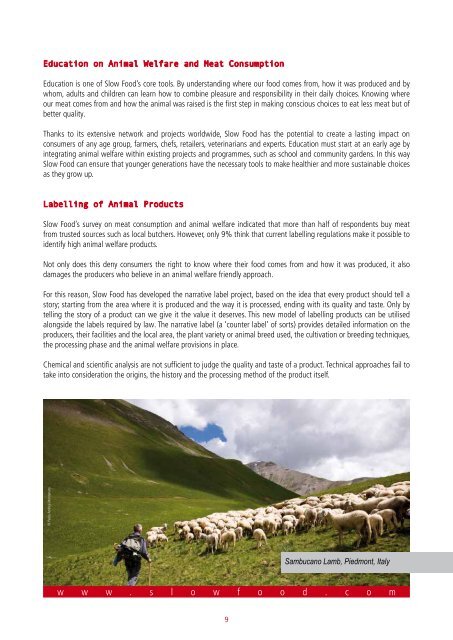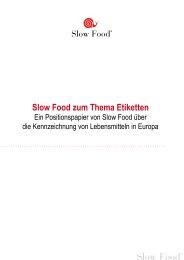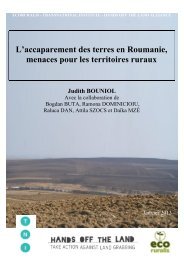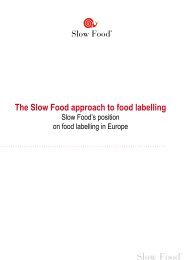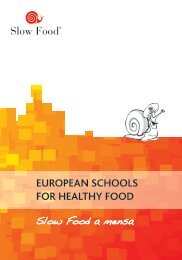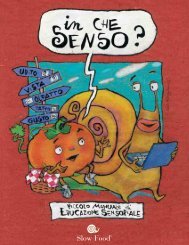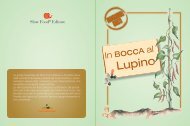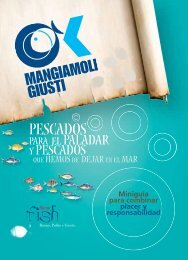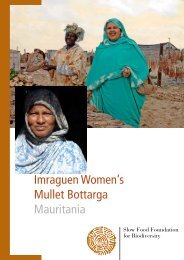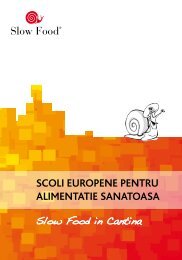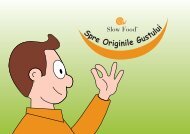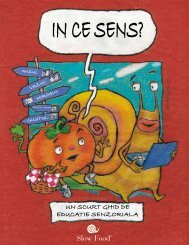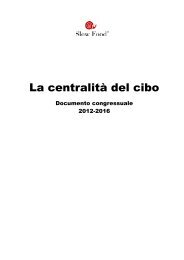Slow Food Policy Paper on Animal Welfare
Slow Food Policy Paper on Animal Welfare
Slow Food Policy Paper on Animal Welfare
You also want an ePaper? Increase the reach of your titles
YUMPU automatically turns print PDFs into web optimized ePapers that Google loves.
Educati<strong>on</strong> <strong>on</strong> <strong>Animal</strong> <strong>Welfare</strong> and Meat C<strong>on</strong>sumpti<strong>on</strong><br />
Educati<strong>on</strong> is <strong>on</strong>e of <str<strong>on</strong>g>Slow</str<strong>on</strong>g> <str<strong>on</strong>g>Food</str<strong>on</strong>g>’s core tools. By understanding where our food comes from, how it was produced and by<br />
whom, adults and children can learn how to combine pleasure and resp<strong>on</strong>sibility in their daily choices. Knowing where<br />
our meat comes from and how the animal was raised is the first step in making c<strong>on</strong>scious choices to eat less meat but of<br />
better quality.<br />
Thanks to its extensive network and projects worldwide, <str<strong>on</strong>g>Slow</str<strong>on</strong>g> <str<strong>on</strong>g>Food</str<strong>on</strong>g> has the potential to create a lasting impact <strong>on</strong><br />
c<strong>on</strong>sumers of any age group, farmers, chefs, retailers, veterinarians and experts. Educati<strong>on</strong> must start at an early age by<br />
integrating animal welfare within existing projects and programmes, such as school and community gardens. In this way<br />
<str<strong>on</strong>g>Slow</str<strong>on</strong>g> <str<strong>on</strong>g>Food</str<strong>on</strong>g> can ensure that younger generati<strong>on</strong>s have the necessary tools to make healthier and more sustainable choices<br />
as they grow up.<br />
Labelling of <strong>Animal</strong> Products<br />
<str<strong>on</strong>g>Slow</str<strong>on</strong>g> <str<strong>on</strong>g>Food</str<strong>on</strong>g>’s survey <strong>on</strong> meat c<strong>on</strong>sumpti<strong>on</strong> and animal welfare indicated that more than half of resp<strong>on</strong>dents buy meat<br />
from trusted sources such as local butchers. However, <strong>on</strong>ly 9% think that current labelling regulati<strong>on</strong>s make it possible to<br />
identify high animal welfare products.<br />
Not <strong>on</strong>ly does this deny c<strong>on</strong>sumers the right to know where their food comes from and how it was produced, it also<br />
damages the producers who believe in an animal welfare friendly approach.<br />
For this reas<strong>on</strong>, <str<strong>on</strong>g>Slow</str<strong>on</strong>g> <str<strong>on</strong>g>Food</str<strong>on</strong>g> has developed the narrative label project, based <strong>on</strong> the idea that every product should tell a<br />
story; starting from the area where it is produced and the way it is processed, ending with its quality and taste. Only by<br />
telling the story of a product can we give it the value it deserves. This new model of labelling products can be utilised<br />
al<strong>on</strong>gside the labels required by law. The narrative label (a ‘counter label’ of sorts) provides detailed informati<strong>on</strong> <strong>on</strong> the<br />
producers, their facilities and the local area, the plant variety or animal breed used, the cultivati<strong>on</strong> or breeding techniques,<br />
the processing phase and the animal welfare provisi<strong>on</strong>s in place.<br />
Chemical and scientific analysis are not sufficient to judge the quality and taste of a product. Technical approaches fail to<br />
take into c<strong>on</strong>siderati<strong>on</strong> the origins, the history and the processing method of the product itself.<br />
© Paolo Andrea M<strong>on</strong>tanaro<br />
Sambucano Lamb, Piedm<strong>on</strong>t, Italy<br />
w w w . s l o w f o o d . c o m<br />
9


